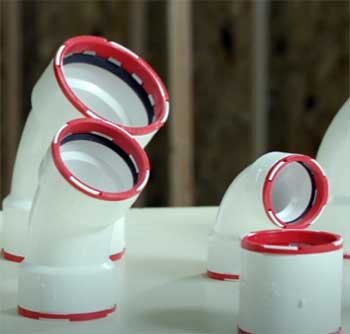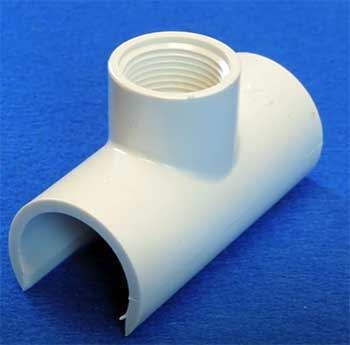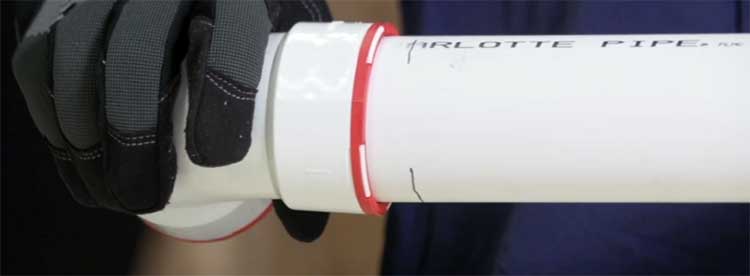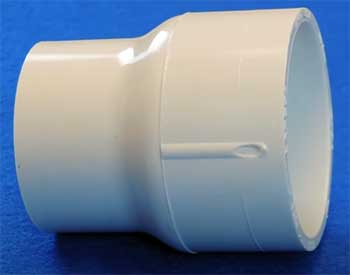As a homeowner tackling a plumbing project, I’ve often stood in the aisle of a hardware store, staring at stacks of PVC pipes, wondering which one’s right for the job. DWV or Schedule 40? Both look similar, but they’re built for different purposes.
In this article, I’ll break down the differences between DWV (Drain, Waste, Vent) and Schedule 40 PVC pipes, sharing their pros, cons, and real-world applications. My goal is to help you make an informed choice for your plumbing needs cover every angle of this comparison.
A Brief Comparison Table
| Feature | DWV PVC Pipe | Schedule 40 PVC Pipe |
| Primary Use | Drain, waste, and vent systems | Pressurized water supply, irrigation |
| Wall Thickness | Thinner (not pressure-rated) | Thicker (rated for pressure, e.g., 280 psi) |
| Pressure Rating | Not for pressurized systems | Suitable for low to moderate pressure |
| Cost | Generally cheaper | More expensive due to thicker walls |
| Fittings | Hub-and-spigot, push-fit connections | Solvent-weld, threaded connections |
| Color | Typically white or dark gray | Typically white or light gray |
| Durability | Less robust, prone to cracking under pressure | Stronger, suitable for demanding applications |
| Common Applications | Sewer lines, drains, vents | Water supply, irrigation, industrial uses |
| Code Compliance | Not for pressure; specific DWV fittings | Approved for pressure and some DWV uses |
| Weight | Lighter due to thinner walls | Heavier due to thicker construction |
Understanding PVC: The Backbone of Modern Plumbing

When I first started working on plumbing projects, I didn’t realize how versatile PVC (Polyvinyl Chloride) is.
It’s a plastic pipe that’s lightweight, corrosion-resistant, and easy to work with compared to old-school materials like copper or cast iron.
But not all PVC is created equal.
DWV and Schedule 40 are both made from unplasticized PVC (PVC-U), which means they’re rigid and durable without added plasticizers.
The key difference lies in their design and intended use, which I’ll unpack as we go.
PVC’s rise to fame started in the 1930s when it began replacing heavier, pricier materials. Its chemical resistance and ease of installation made it a go-to for plumbers. Whether you’re running a drain line or setting up a water supply, PVC’s got you covered—but only if you pick the right type.
Let’s explore what sets DWV and Schedule 40 apart.
What Is DWV Pipe?
DWV stands for Drain, Waste, and Vent. As the name suggests, this pipe is designed for gravity-fed systems that handle wastewater, sewage, and ventilation. I’ve used DWV pipe in projects like installing a new bathroom drain or extending a sewer line.
It’s built to let water and waste flow smoothly without needing to withstand internal pressure.
Key Features of DWV Pipe
- Thinner Walls: DWV pipes have thinner walls than Schedule 40, making them lighter and cheaper. This is because they don’t need to handle pressurized fluids.
- Hub-and-Spigot Fittings: These pipes use fittings called “hubs,” which are shallower than Schedule 40 fittings. They’re designed for easy connection in gravity systems.
- Not Pressure-Rated: DWV pipes are explicitly labeled “NOT FOR PRESSURE” to prevent misuse in pressurized systems like water supply lines.
- Common Uses: You’ll find DWV in sewer lines, bathtub drains, and venting systems that prevent sewer gases from entering your home.
- Color and Labeling: Often white or dark gray, DWV pipes usually have clear markings to distinguish them from other PVC types.
Pros of DWV Pipe
- Cost-Effective: Because they use less material and skip pressure testing, DWV pipes are typically 20-30% cheaper than Schedule 40. This saved me a chunk of change when I redid my basement drain.
- Lightweight: The thinner walls make DWV easier to handle, especially for long runs or overhead venting.
- Easy to Install: Hub fittings and solvent-weld connections make DWV systems straightforward to assemble, even for a DIYer like me.
- Wide Range of Fittings: From P-traps to cleanouts, DWV fittings are tailored for drainage, making it easy to build a complete system.
- Corrosion Resistance: Like all PVC, DWV won’t rust or corrode, even in damp environments like sewer lines.
Cons of DWV Pipe
- Not for Pressure: DWV can’t handle pressurized systems. I learned this the hard way when I mistakenly used a DWV pipe for a sprinkler system—it cracked under pressure.
- Thinner Walls: The reduced thickness makes DWV less durable for heavy-duty applications or where physical stress is a factor.
- Code Restrictions: Some building codes don’t allow DWV for certain applications, like radon venting, where Schedule 40 is required.
- Limited Versatility: You’re restricted to non-pressurized systems, so DWV isn’t a one-size-fits-all solution.
What Is Schedule 40 Pipe?
Schedule 40 PVC is the workhorse of pressurized plumbing systems. I’ve used it for everything from irrigation lines to cold-water supply in my home. It’s thicker, stronger, and built to handle low to moderate pressure, making it more versatile than DWV.
Key Features of Schedule 40 Pipe

- Thicker Walls: Schedule 40 has a thicker wall than DWV, with a minimum thickness of 0.216 inches for a 3-inch pipe, compared to DWV’s 0.070 inches.
- Pressure-Rated: Often rated for pressures like 280 psi (for 3-inch pipes), Schedule 40 is designed for water supply and irrigation.
- Solvent-Weld or Threaded Fittings: These fittings are deeper and more robust, ensuring a secure seal under pressure.
- Common Uses: You’ll see Schedule 40 in water mains, irrigation systems, and even some DWV applications where codes allow.
- Color and Labeling: Typically white or light gray, with clear markings indicating “Schedule 40” and pressure ratings.
Pros of Schedule 40 Pipe
- High Durability: The thicker walls make Schedule 40 tough enough for pressurized systems and environments with physical stress.
- Versatile Applications: It’s approved for both pressure and some non-pressure uses, giving me flexibility in projects.
- Code Compliance: Schedule 40 meets stricter building codes, like those for radon venting or water supply, which DWV often can’t.
- Pressure Handling: Rated for significant pressure, it’s ideal for water lines or irrigation systems where reliability is critical.
- Long Lifespan: Like DWV, Schedule 40 resists corrosion and can last decades with proper installation.
Cons of Schedule 40 Pipe
- Higher Cost: The thicker walls and pressure testing make Schedule 40 about 20-30% more expensive than DWV.
- Heavier Weight: It’s noticeably heavier, which can make long runs or overhead installations a bit of a workout.
- Overkill for Some Uses: For simple drainage or venting, Schedule 40’s extra strength is unnecessary, driving up costs.
- Complex Fittings: Threaded connections can be trickier to work with compared to DWV’s hub fittings, especially for beginners.
Comparing DWV And Schedule 40: A Real-World Perspective
When I was extending a drain line for my downspouts, I faced the DWV vs. Schedule 40 dilemma. The existing system used Schedule 40, but DWV was tempting because it was cheaper. Here’s how I broke it down:
- Application Needs: My downspout drain was a gravity-fed system, moving rainwater away from the house. DWV was perfectly suited since no pressure was involved. However, if I were running a water supply line, Schedule 40 would’ve been non-negotiable.
- Cost Considerations: DWV saved me about $50 on a 20-foot run compared to Schedule 40. For a budget-conscious project, that’s significant.
- Durability Concerns: Since the drain wasn’t under a driveway or subject to heavy loads, DWV’s thinner walls were fine. But for buried water lines, I’d stick with Schedule 40’s strength.
- Code Compliance: I checked local codes, which allowed DWV for drainage but required Schedule 40 for any pressurized or structural applications.
In the end, I went with DWV for the downspout project and haven’t had issues in three years. But for my irrigation system, Schedule 40 was the only choice due to water pressure.
Practical Applications: Where Each Pipe Shines
DWV in Action

I’ve used DWV pipes for several home projects, and they’re fantastic for specific tasks. For example, when I installed a new shower drain, DWV’s hub fittings made it easy to connect to the existing sewer line. The thinner walls kept costs down, and the lightweight design meant I could handle 10-foot sections without breaking a sweat. DWV is also ideal for:
- Sewer Lines: Moving wastewater from your home to the municipal system.
- Vent Systems: Preventing sewer gases from entering your home by allowing air into the plumbing.
- Drainage Projects: Like my downspout extension, where gravity does the work.
One tip: always check for the “NOT FOR PRESSURE” label to avoid costly mistakes.
Schedule 40 in Action
Schedule 40 is my go-to for anything involving pressure. When I set up a drip irrigation system for my garden, Schedule 40’s thick walls handled the water pressure without issue. It’s also great for:
- Water Supply Lines: Delivering potable water to faucets or appliances.
- Irrigation Systems: Ensuring consistent water flow for sprinklers or drip lines.
- Structural Uses: Some codes allow Schedule 40 for non-plumbing applications, like protective sleeves for wiring.
One downside: the heavier weight can make overhead installations tiring, so plan accordingly.
Mixing DWV and Schedule 40: A Risky Move?

A common question I’ve heard (and asked myself) is whether you can mix DWV and Schedule 40 in the same system.
Technically, they can fit together because they often share the same outer diameter and threading (NPT). But here’s the catch: it’s not recommended.
When I tried using a DWV fitting on a Schedule 40 pipe for a drain line, it seemed fine at first but leaked under slight pressure. Why?
- Pressure Mismatch: DWV fittings aren’t tested for pressure, so using them in a Schedule 40 system risks failure.
- Fitting Differences: DWV’s hub fittings are shallower than Schedule 40’s, leading to weaker joints.
- Code Violations: Most building codes prohibit mixing them in pressurized systems to ensure safety.
If you’re tempted to mix them to save money, don’t. Stick to the right pipe for the job to avoid headaches.
Cost Analysis: Budgeting For Your Project
When I’m planning a plumbing project, cost is always a factor. Here’s a rough breakdown based on my experience at big-box stores:
- DWV Pipe: A 10-foot section of 3-inch DWV costs about $10-$15.
- Schedule 40 Pipe: The same size in Schedule 40 runs $15-$20.
- Fittings: DWV fittings (like P-traps or cleanouts) are about 10-20% cheaper than Schedule 40 equivalents.
For a 50-foot drain line, DWV could save you $25-$50 overall. But if you’re running a pressurized system, the extra cost of Schedule 40 is worth it for reliability.
Code Compliance and Safety
Building codes are a big deal, and I’ve learned to check them before starting any project. DWV pipes are approved for drainage and venting but often fail to meet codes for pressurized systems or specific applications like radon venting. Schedule 40, with its thicker walls and pressure ratings, is more versatile and often required for:
- Water Supply: Most codes mandate Schedule 40 or CPVC for potable water.
- Radon Venting: DWV is typically not allowed due to its thinner walls.
- Buried Lines: Schedule 40’s durability makes it suitable for underground installations.
Always consult your local building department to avoid failing inspections.
Environmental and Durability Factors
Both DWV and Schedule 40 are made from PVC-U, so they’re resistant to corrosion, chemicals, and UV degradation (to an extent). However, Schedule 40’s thicker walls give it an edge in harsh environments, like buried lines exposed to soil movement.
DWV’s thinner walls are fine for indoor or protected outdoor use but can crack if subjected to physical stress.
I’ve also considered the environmental impact. PVC production isn’t the greenest process, but both pipes are recyclable and have long lifespans (50+ years with proper use). Choosing the right pipe reduces waste from failed installations, so it’s a small win for sustainability.
Installation Tips From Experience
Having worked with both pipes, here are some tips I’ve picked up:
- For DWV: Use primer and cement for secure joints. Ensure proper slope (1/4 inch per foot) for gravity drainage.
- For Schedule 40: Double-check pressure ratings for your application. Use threaded fittings sparingly, as they’re prone to leaks if not sealed properly.
- Tools: A PVC cutter makes clean cuts, and a deburring tool smooths edges for better joints.
- Safety: Wear gloves and work in a ventilated area when using solvent cement—it’s strong stuff.
Frequently Asked Questions (FAQ)
Use DWV for non-pressurized drain, waste, and vent systems. Choose Schedule 40 for pressurized applications like water supply or irrigation. Check local codes for compliance.
Yes, DWV and Schedule 40 PVC can be glued together using PVC primer and cement, but mixing them isn’t recommended due to pressure and code issues.
Yes, Schedule 40 can be used for sewer lines in some cases, but DWV is often preferred for cost and ease of use in gravity-fed systems.
DWV isn’t technically a “schedule” pipe, as it’s not pressure-rated. It’s a separate category designed for drain, waste, and vent applications with thinner walls.
Conclusion: Making The Right Choice For You
Choosing between DWV and Schedule 40 comes down to your project’s needs, budget, and local codes. I’ve shared my experiences to help you navigate this decision, whether you’re fixing a drain or installing a water line.
DWV is your budget-friendly, lightweight option for gravity-fed systems, while Schedule 40’s strength makes it ideal for pressurized applications. By understanding their pros, cons, and applications, you can confidently pick the right pipe and avoid costly mistakes.
Got a plumbing project coming up? Let me know in the comments what you’re working on—I’d love to hear about it!
